| |
 |
 |
 |
 |
 |

Figure 2 |
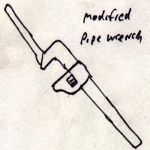
Figure 3 |

Figure 4 |
 |
| BILL EPPS |
 |
These are some of the tools that I use when I am making things out of RailRoad spikes. Fig. 2 is a special pair of tongs made to hold the RR Spike by the head, also it can hold it vertically by the shank. Fig 3 is a offset adjustable wrench w/a handle welded on it that I use for twisting. Fig. 4 is is a top and bottom fuller that fits in the hardy hole that I will explain later.
|
 |
|
|
 |

Figure 5 |
This is a guillotine tool which is another fullering tool that I use on these RR Spike Knives.
|
 |
 |

Figure 1 |

Figure 6 |

Figure 7 |
 |
BILL EPPS
|
 |
I am starting with a RR Spike that has an HC mark on the top of the head. (These are Carbon Steel RR Spikes). I put some kind of decorate twist on all the handles. On this particular one, we are putting a split on all 4 sides about 3 1/2" down from the head, and then heat it real good and twist it.
|
 |
 |

Figure 8 |
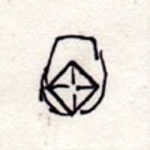
Figure 9 |

Figure 10 |
 |
BILL EPPS
|
 |
After making the twist (which will be the handle), I like to end up with the point of the spike on the BIAS (or diamond). This gives me a little bit more spread when I start flattening out the blade.
|
 |
 |

Figure 10 |
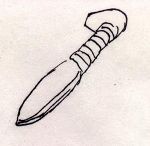
Figure 11 |

Figure 12 |
 |
BILL EPPS
|
 |
I start hammering it down on the bias until I get a flat blade, which at this point is about 3/8" thick. Then I use the fuller tool, the length of the blade to give it more spread.
|
 |
 |
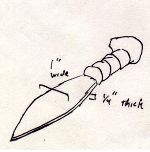
Figure 13 |
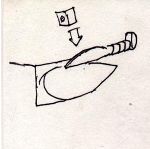
Figure 14 |
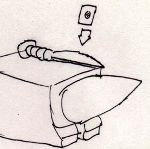
Figure 15 |
 |
BILL EPPS
|
 |
You do not want to forge the blade down too thin. You need to leave it thick enough to have stock to grind. I start the shape of the blade on the anvil. Then I come to the face and start thinning down the edge slightly
|
 |
 |

Figure 16 |

Figure 17 |

Figure 18 |
 |
BILL EPPS
|
 |
I forge it until the blade is about 4" long, and an inch to inch 1/4 wide. I like to leave the spine 3/16 to 1/4" thick.
|
 |
 |
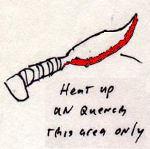
Figure 19 |
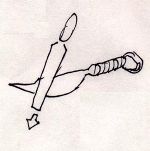
Figure 20 |
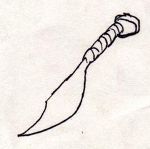
Figure 21 |
 |
BILL EPPS
|
 |
Then I rough grind the blade and I harden it. I do this by heating the whole blade to a good forging heat, and I quench the working part ONLY, the bottom 1/2 of the blade, ie. the cutting edge only. I just use plain water to quench. Test it w/a file(a good Mill Bastard File). When the file squeaks, it is about right. Now I do quench the blade pointing Due North (I don't know if it really makes any difference or not, but it seems to work best for me). After I test it w/a file, then I use the carry over heat to put a little bit of temper in it. I do this by when it comes to a straw color, I put the cutting edge only until the color leaves the back of the blade. Then go to the grinder and grind and polish to suit (I don't put much polish on them).
|
 |
 |
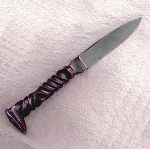
Figure 0 |
|
 |
BILL EPPS
|
 |
Any questions???
|
 |
JOCK D.
|
 |
I always thought RR-Spike knives were a strange thing to make but apparently there is quite a number of collectors out there that collect them.
|
 |
JOCK D.
|
 |
This is a pretty one!
|
 |
Steve
|
 |
How much do you sell these for?
|
 |
dunchadh
|
 |
where do you find high carbon spike
|
 |
Ntech
|
 |
Nice project Bill, thanks.
|
 |
BILL EPPS
|
 |
There are quick and easy to make, inexpensive, and make a pretty fair knife. Some makers get real fancy w/them, but these are the basics here.
|
 |
jj2k
|
 |
Bill how much does a knife like that one sell for?
|
 |
BILL EPPS
|
 |
$50 to $60, depending what kind of twist or how creative you get w/the handle. I have a guy that grinds the blades for me. I am not that good at blade grinding.
|
 |
ceridwen
|
 |
nice demo, seems clear and easy to follow...gotta try one sometime
|
 |
BILL EPPS
|
 |
Like I said, look on the top of the RR Spike. They will say HC. The narrow Gauge RR Spikes and some of the other spikes are just A-36 Hot Roll steel. But the ones used by the major Railroads, are HC or High Carbon Spikes.
|
 |
JOCK D.
|
 |
Starting on the diagonal gives you 1.4 times the starting width of working on the flat AND the points help concentrate the force making it easier to forge flat.
|
 |
BILL EPPS
|
 |
Thanks Jock, I wasn't sure how much dimension it gave me, I just knew that it gave me more spread than doing it the other way.
|
 |
JOCK D.
|
 |
I always do leaves that way and its much easier to get good width. And on some items starting with the sharp edge works nicely.
|
 |
BILL EPPS
|
 |
Guess it is time to go back to the Pub
|
 |
AZ-DOUG
|
 |
How's the steel in RR spikes for a knife, generally?
|
 |
ceridwen
|
 |
Gotta have the HC spikes, but I have heard that they are still not super high
carbon.
|
 |
JOCK D.
|
 |
HC spikes are about 40 point carbon. Makes a usable edge but not the best.
You will note Bill is hardening and not tempering. That is why.
|
 |

